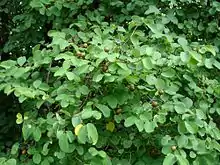Cleistanthus collinus
Cleistanthus collinus[2] is a plant species first described by Roxburgh, with its current name after Bentham and Hooker; it is included in the family Phyllanthaceae.[3][4] The IUCN categorizes this species as vulnerable.[1] No subspecies are listed in the Catalogue of Life.[3]
| Cleistanthus collinus | |
|---|---|
_in_Narsapur_forest%252C_AP_W_IMG_0165.jpg.webp) | |
| Scientific classification | |
| Kingdom: | Plantae |
| Clade: | Tracheophytes |
| Clade: | Angiosperms |
| Clade: | Eudicots |
| Clade: | Rosids |
| Order: | Malpighiales |
| Family: | Phyllanthaceae |
| Genus: | Cleistanthus |
| Species: | C. collinus |
| Binomial name | |
| Cleistanthus collinus | |
| Synonyms | |
|
Lebidieropsis orbiculata var. lambertii | |
Properties
Cleistanthus collinus (Karra) contains a plant poison also called oduvan (Tamil), kadise (Kannada), Vadisaku (Telugu), Oduku (Malayalam) and Gaja Madara (Sinhala) . Ingestion of its leaves or a decoction of its leaves causes hypokalemia (kaliuresis and cardiac arrhythmias),[5] metabolic acidosis, hypotension and hypoxia[6] probably due to distal renal tubular acidosis, ARDS and toxin induced vasodilatation respectively.[7][8][9] Hypokalemia and acidosis probably also induces rhabdomyolysis resulting in myoglobinuric kidney failure and neuromuscular weakness.[10] Its effects are probably mediated by injury to the distal renal tubules, pulmonary epithelium and peripheral blood vessels due to glutathione depletion[11] (animal studies have shown benefit with N-acetylcysteine).[12]
Cleistanthin A and cleistanthin B are phytoconstituents of C. collinus. Cleistanthin A and cleistanthin B are arylnaphthalide lignans. They have been reported to be toxic substances responsible for poisoning. Cleistanthin A is also present in Phyllanthus taxodiifolius.[13]
Gallery
 Karra at fruiting
Karra at fruiting_in_Narsapur_forest%252C_AP_W_IMG_0166.jpg.webp)
_in_Narsapur_forest%252C_AP_W_IMG_0168.jpg.webp)
_in_Narsapur_forest%252C_AP_W_IMG_0169.jpg.webp)
References
- World Conservation Monitoring Centre (1998). "Cleistanthus collinus". IUCN Red List of Threatened Species. 1998: e.T34271A9855293. doi:10.2305/IUCN.UK.1998.RLTS.T34271A9855293.en.
- Benth. ex Hook.f., 1887 In: Fl. Brit. India 5: 274
- Roskov Y.; Kunze T.; Orrell T.; Abucay L.; Paglinawan L.; Culham A.; Bailly N.; Kirk P.; Bourgoin T.; Baillargeon G.; Decock W.; De Wever A. (2014). Didžiulis V. (ed.). "Species 2000 & ITIS Catalogue of Life: 2014 Annual Checklist". Species 2000: Reading, UK. Retrieved 26 May 2014.
- WCSP: World Checklist of Selected Plant Families
- Thomas, K; Dayal, AK; Narasimhan, Alka G; Seshadri, MS; Cherian, AM; Kanakasabapathi, Molly B (1991). "Metabolic and Cardiac effects of Cleistanthus Collinus poisoning". J Assoc Physicians India. 39 (4): 312–314. PMID 1938816.
- Subrahmanyam, DK; Mooney, T; Raveendran, R; Zachariah, B. A (Nov 2003). "Clinical and laboratory profile of Cleistanthus collinus poisoning". J Assoc Physicians India. 51: 1052–4. PMID 15260387.
- Eswarappa, S.; Chakraborty, A R; Palatty, B U; Vasnik, M (2003). "Cleistanthus Collinus Poisoning: Case Reports and Review of the Literature". Clinical Toxicology. 41 (4): 369–72. doi:10.1081/clt-120022005. PMID 12870879. S2CID 20225328.
- Benjamin SPE, M Edwin Fernando, JJ Jayanth, Preetha B; Cleistanthus collinus poisoning. J Assoc Physicians India 2006 Sep; 54:742-44
- Nampoothiri, K; Chrispal, A; Begum, A; Jasmine, S; Gopinath, KG; Zachariah, A (Mar 2010). "A clinical study of renal tubular dysfunction in Cleistanthus collinus (Oduvanthalai) poisoning". Clin Toxicol. 48 (3): 193–7. doi:10.3109/15563651003641786. PMC 2875161. PMID 20397801.
- Eswarappa, Benjamin SPE (Jan 2007). "Renal failure and neuromuscular weakness in Cleistanthus collinus poisoning". J Assoc Physicians India. 55: 85–86. PMID 17447300.
- Sarathchandra, G; Balakrishnamoorthy, P. "Acute toxicity of Cleistanthus collinus, an indigenous poisonous plant in Cavia procellus". Journal of Environmental Biology. 1998: 145–8.
- Annapoorani, KS; Damodaran, C; Chandrasekharan, P (1986). "A promising antidote to Cleistanthus collinus poisoning". J Sci Soc Ind. 2: 3–6.
- Parasuraman, S; Raveendran, R (2012). "Diuretic effects of cleistanthin a and cleistanthin B from the leaves of cleistanthus collinus in wistar rats". J Young Pharm. 4 (2): 73–7. doi:10.4103/0975-1483.96616. PMC 3385220. PMID 22754257.
 Media related to Cleistanthus collinus at Wikimedia Commons
Media related to Cleistanthus collinus at Wikimedia Commons Data related to Cleistanthus collinus at Wikispecies
Data related to Cleistanthus collinus at Wikispecies
